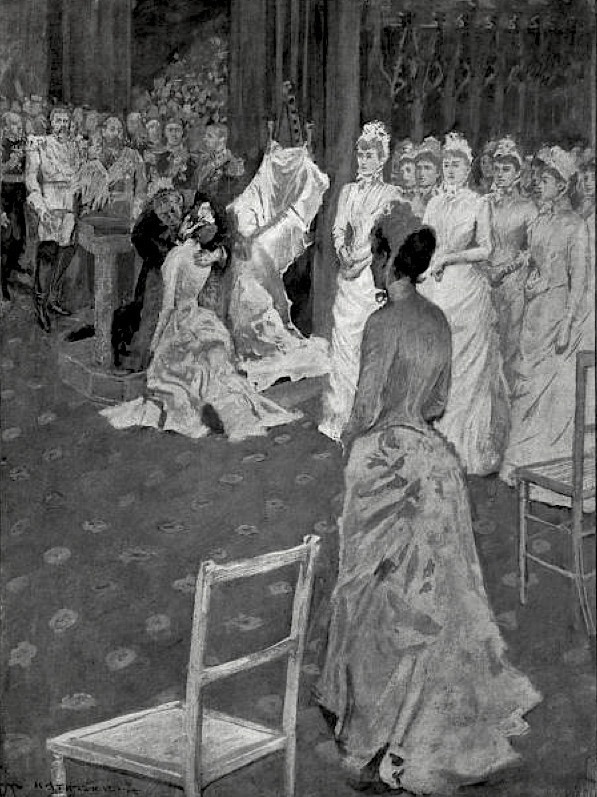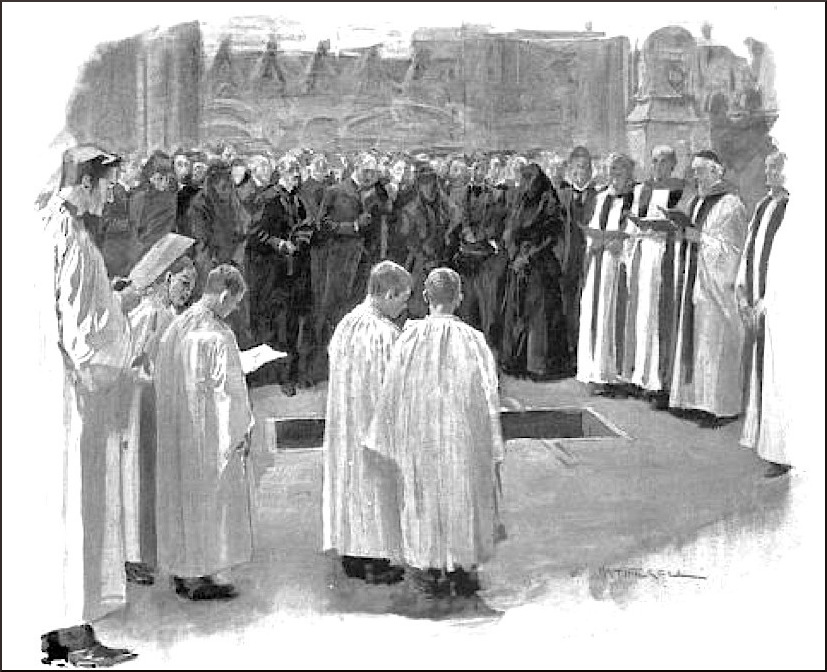Click on the images to enlarge them and for more information where available. You may use all of them without prior permission for any scholarly or educational purpose as long as you (1) credit the photographer or source, and (2) link your document to this URL in a web document or cite the Victorian Web in a print one.


Left: Westminster Abbey and the Funeral of Edward the Confessor (Bayeux Tapestry). Source: illustration in Hiatt, p. 3. Right: The Coronation of William the Conqueror. Source: illustration in Bradley, p. 17.
Westminster Abbey, where Edward the Confessor was buried and William I was crowned, is still in use for its original purposes and is magnificently on show at great state occasions. It is, perhaps the single most prized of our medieval buildings. It is also one of the best documented. Wonderful, then, to have this model of medieval craftsmanship available for us to study. But how medieval is the Abbey as it is today, really?
When the architect W. R. Lethaby was appointed Surveyor to the Dean and Chapter of Westminster Abbey in 1906, he echoed complaints made by William Morris about restoration work in general, and pointed out in connection with the North Transept,
THE exterior of the church has been subjected to such a series of injuries and "improvements" that hardly one old stone of it remains upon another. The original form of the once so beautiful North Transept, with its three great portals, had to a large extent disappeared under a layer of alterations even before the great restoration (1875-90) which made all false.
The Westminster transepts were of such extraordinary interest as showing the progress of London building in the middle of the thirteenth century, that it is worth some trouble to gather up the evidence as to their original form before they were made over in the "Early English" of to-day.
Without being a student of records it is impossible to tell what is even an echo of the ancient work. The expert re-editing of old buildings, with all its pretensions to science, comes in practice to a muddling up of so much copy of old work, so much conjecture, and so much mere caprice, without leaving any record as to which is which. This actual obliteration of authentic remnants and evidence is what we call Restoration. [63]
The fact is that Lethaby had taken office after several Victorian architects who, however well-intentioned, were less than scrupulous in their approach. When Edward Blore held the position from 1827-1849, his alterations to the Choir aroused the wrath of the Ecclesiological Society even at the time: "In truth we cannot think without deep sorrow upon Westminster Abbey in the hands of this architect," thundered (or wept) the Ecclesiologist. "he is entirely unacquainted with the true spirit of Pointed Architecture; and therefore is manifestly unfit for the charge of any works in Westminster Abbey" (99).
George Gilbert Scott, who followed Blore (with his son, J. O. Scott, according to his written wishes, completing work in hand), should have merited more praise: he loved holding the position, seeing it as "a great and lasting source of delight," and set out at once on "a careful investigation of its antiquities" (151). However, Scott himself admitted that he sometimes needed to sacrifice "objects of antiquity in order to comply with pressing practical wants" (154), and he did not escape blame either, for such faults as depending on doubtful authority, or being careless in other ways. In talking about his restoration of the Chapter House, for example, Lethaby frowns on Scott's rash and detrimental use of French Polish on the "splendid entrance to the vestibule.... without adequate experiment" (42). That may sound fairly trivial, but in fact it could be disastrous, since the varnishing darkened with time, and then, as damp built up behind it, began to fall off, taking with it some of the surface itself.


Two very early twentieth-century photographs. Left: The Nave, Choir Stalls and Chancel. Right: An old postcard showing Poets' Corner.
When Scott's successor, John Loughborough Pearson, took over in 1879 he proved just as controversial. Getting to work on the upper part of the north front, which Scott had not yet reached, he made changes to the rose window itself. In 1902 Charles Hiatt looked at the work of both men here, and wrote drily: "The most ambitious alteration has been that of the north front under Sir Gilbert Scott and Mr. J. L. Pearson. This had been rebuilt by Wren and his pupils, whose work, if in this position somewhat incongruous, had merits which we fail to discover in the structure which now takes its place" (15). Pearson remained in the post until 1897.


Two illustrations in Bradley. Left: Queen Victoria (in black) embraces all the members of her family at the Thanksgiving Service at the Abbey on 21 June 1887, on the occasion of her Golden Jubilee (p. 371). Right: Tennyson's funeral in the Abbey, on 12 October 1891 (facing p. 376).
Only in 1879 with the next surveyor, Scott's former pupil John Thomas Micklethwaite (1843-1906), did a new kind of policy start to appear, and that only slowly and partially. Micklethwaite made no criticism of his old mentor, noting apparently approvingly that after Scott's death, "his designs were in the main adhered to," and that Wren's work on the whole eighteenth-century front had indeed been "transformed back to the Early English style" and "the whole exterior end of the north transept ... completed," so that at long last the scaffolding there could come down (368). But he does correct himself when talking about this as a restoration, pointing out that it is more accurately termed a rebuilding. As for his own own rebuilding of the north buttress with "authentic Perpendicular features," a late twentieth-century commentator, Thomas Cocke, writes that it is unclear whether Micklethwaite's "restraint was caused by shortage of money or whether it was because he had a different cast of mind from Scott and Pearson and was less interventionist in matters of design" (90). Micklethwaite certainly does go into some detail about "financial difficulties" (368).
It was only really with Lethaby himself that William Morris's strictures in his famous Manifesto had their effect. The new Surveyor took care not to tamper with the Abbey — not to try to produce what Morris saw as a "forgery" of the original — or indeed of an imagined original. Concentrating on maintenance and careful cleaning (no French Polish!), Lethaby actively put into practice the policy of the SPAB (the Society for the Protection of Ancient Buildings, which Morris and others had founded in 1877), not to interfere with earlier work as a matter of rigorous principle. That included the Victorian work itself: "Now it is done don't alter it; I would not meddle even with the restoration of a restorer," said Lethaby (78). His success here, with the most conservative of methods, proved tremendously influential.


Left: Victorian photograph giving a three-quarter view of the west front of the Abbey. Right: Contemporary photograph from more directly opposite, showing George Gilbert Scott's Westminster School Memorial Column, unveiled in 1861, commemorating old boys from Westminster School who died in the Crimea and during the Indian Mutiny (see Bullus 244).
There is no doubt that what we see today is partly the Victorians' take on this medieval treasure, as conserved for us by later, more enlightened architects. But we too have added our mark to it: in July 1998 ten new statues were unveiled on the west front, in niches which had been empty since the Middle Ages. They memorialise ten modern martyrs, including St Elizabeth of Russia (killed in 1918 during the Russian Revolution) and Martin Luther King (see "Westminster Abbey's Royal Martyrs"). Yet even these figures are now hallowed by age and custom, so that the Abbey as a whole seems as ancient a part of our built heritage as it did in earlier times.
Sources
Bradley, E. T. (Mrs A. Murray Smith) Annals of Westminster Abbey. London: Cassell, 1898. Internet Archive. Contributed by Robarts Library, University of Toronto. Web. 10 July 2015.
Bullus, Claire & Ronald Asprey. The Statues of London. London and New York: Merrell, 2009.
Cocke, Thomas. 900 Years: The Restorations of Westminster Abbey. London: Harvey Miller for The Dean & Chapter of Westminster, 1995.
Hiatt, Charles. Westminster Abbey: A short history and description of the church and conventual buildings with notes on the monuments. London : G. Bell, 1902. Internet Archive. Contributed by Robarts Library, University of Toronto. Web. 10 July 2015.
Lethaby, W. R. Westminster Abbey and the Kings' Craftsmen : A study of Mediaeval Buildings. London: Duckworth, 1906. Internet Archive. Contributed by Robarts Library, University of Toronto. Web. 10 July 2015.
Micklethwaite, J. T. "On the Abbey Buildings at Westminster." In Annals of Westminster Abbey by E. T. Bradley (Mrs A. Murray Smith). London: Cassell, 1898. Internet Archive. Contributed by Robarts Library, University of Toronto. Web. 10 July 2015.
Morris, William. Manifesto. Web. 10 July 2015.
Scott, Sir George Gilbert, R.A. Personal and Professional Recollections, edited by his son, G. Gilbert Scott, F.S.A. London: Sampson Low, Marston, Searle, & Rivington, 1879. Internet Archive. Contributed by the University of California Libraries. Web. 10 July 2015.
"Westminster Abbey." The Ecclesiologist, Vol. III, no. XXXI (May 1844). Cambridge: Stevenson, 1844. 368-93. Internet Archive. Contributed by the library of Harvard University. Web. 10 July 2015.
"Westminster Abbey's modern martyrs." Times. 10 July 1998: 4. The Times Digital Archive. Web. 10 July 2015.
Recommended Reading
Reynolds, Christine, ed. Surveyors of the Fabric of Westminster Abbey, 1827-1906: Reports and Letters (Westminster Abbey Record Series). Martlesham, Suffolk: Boydell, 2011.
Created 13 July 2015